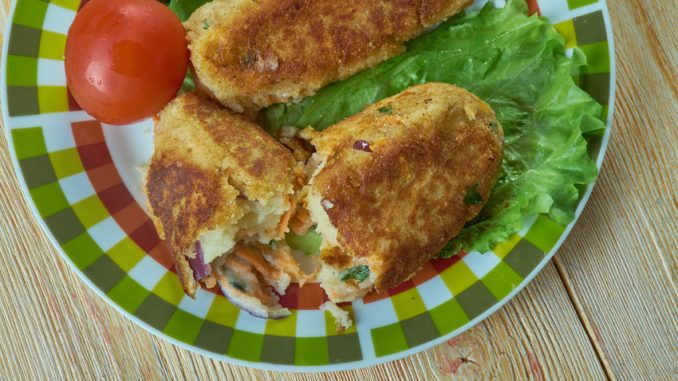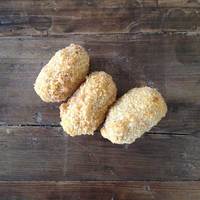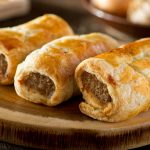
For me, there are a couple of foods which you associate with Wales that have become mainstream on the dinner table and one is the Glamorgan sausage. The peculiarity of this sausage is that it is in fact a meatless and skinless type but that does not make it a pale imitation of the truly meaty version. When I’ve eaten it in cafes, I have it served with mash and baked beans in London and I’m never disappointed. In more select restaurants, it is served with onion marmalade or chutney sauces to add a bit of sweetness and bite.
Which cheese to use?
It is also known as the ‘Glamorgan Cheese Sausage’. Why? It is obvious surely. The main ingredient is cheese which is usually Cheddar (Welsh or English) or Caerphilly. Caerphilly is not as common as Cheddar. John Torode suggests Cheshire as an alternative too in his recipe book ‘My Kind of Food: Recipes I Love to Cook at Home’. The original cheese may well have been Glamorgan which was produced from the milk of a breed known as the Glamorgan. There simply are not enough of these cattle about to make it’s production viable but who knows given the renewed interest in rarer breeds.
Cheese is often used in that other great Welsh snack, the Welsh Rarebit. Incidentally, the meatless nature of the sausage echoes the vegetarian status of that dish. The sausage also contains breadcrumbs, leeks or spring onions depending the level of flavour required. Plenty of herbs such as parsley, thyme, rosemary, various seasonings which can include mustard and all bound with egg. The sausages are shaped into cylinders then fried – always. A coating of flavoured breadcrumbs helps to provide a certain amount of crunch.
Comments & Variants
Jane Grigson wrote in the Observer Guide to British Cooking (1984) of a quote by George Borrow from his tome ‘Wild Wales; Its People, Language And Scenery’ published in 1862:-
“The breakfast was delicious, consisting of excellent tea, buttered toast, and Glamorgan sausages, which I really think are not a whit inferior to those of Epping’.
The Epping sausage refers to another skinless type but with meat. The dish probably originated as a result of meat rationing after the war although it appears to have been around well before then.
 Bodnant Welsh Food offer a traditional award winning Glamorgan sausage with their award-winning Aberwen cheese, wholegrain mustard and spring onions, wrapped in a crisp breadcrumb coating.
Bodnant Welsh Food offer a traditional award winning Glamorgan sausage with their award-winning Aberwen cheese, wholegrain mustard and spring onions, wrapped in a crisp breadcrumb coating.
A typical recipe is as follows:-
Ingredients
Preparation time: between 20 and 30 minutes
Cooking time: 30 minutes to 1 hour
Serving number: 4
- 25g (1oz.) butter
- 115g (4oz.) leeks used in the dish, trimmed, finely shredded or sliced
- 175g (6oz) fresh white breadcrumbs or you can try a mix of white and brown. About 100g of these are for the main body of the sausage and the remainder are for the coating.
- 1 tbsp chopped fresh thyme
- 150g (5oz) Caerphilly cheese, Cheshire or Welsh Cheddar, finely grated
- 2 large free-range eggs, separated (or 3 eggs if they are small-medium sized)
- 1 tsp English mustard (ready prepared) or 1/2 tsp dry mustard
- ½ tsp salt
- 5 tbsp sunflower oil
- freshly ground black pepper
- 2 tbsp chopped fresh parsley
Preparation
- Prepare the sausages by melting the butter in a large non-stick frying pan. The leeks are fried gently until they soft but not browned. This usually takes between 7 and 9 minutes. Allow to cool slightly.
- Mix thoroughly the breadcrumbs (about 100g (3 ½oz.)), cheese, mustard, softened leeks, parsley and seasoning in a mixing bowl. Mix well until you have a consistent mass.
- Separate the eggs.
- Add the egg yolks to the mixture. Use a wooden spoon to fold these yolks mixed really well.
- Divide the whole mixture into 8 sausage shapes.
- Put 40g-50g (1 1/2oz.) of breadcrumbs on a board to use for the coating.
- Whisk the egg whites in a bowl.
- Dip each sausage in the beaten egg whites and then roll in the breadcrumbs. Try to get an even coating where possible – the ends appear the trickiest.
- I usually chill in the fridge for up to a half-hour although when pushed you can just leave out to cool down.
- Heat some maize or corn oil in a non-stick frying pan and fry the sausages on a medium heat for between 12 and 15 minutes – no shorter really. Turn regularly to achieve a uniform golden brown colour.
Serve two per person with tomato, lettuce or a seasonal salad, relish, various sauces etc.
If you like the cooking of John Torode then try his recipe book:
We have an affiliates disclosure so please be aware of the link to Amazon UK. Hope you enjoy the recipes.

The welsh for a Glamorgan sausage is Selsig Morgannwg. You often see Morgannwg on the county signs so I just think of this and it makes me go out and a buy a few for tea. Look for Bobby Freeman’s recipes in the Guardian.
Love it. Need a recipe for this one!